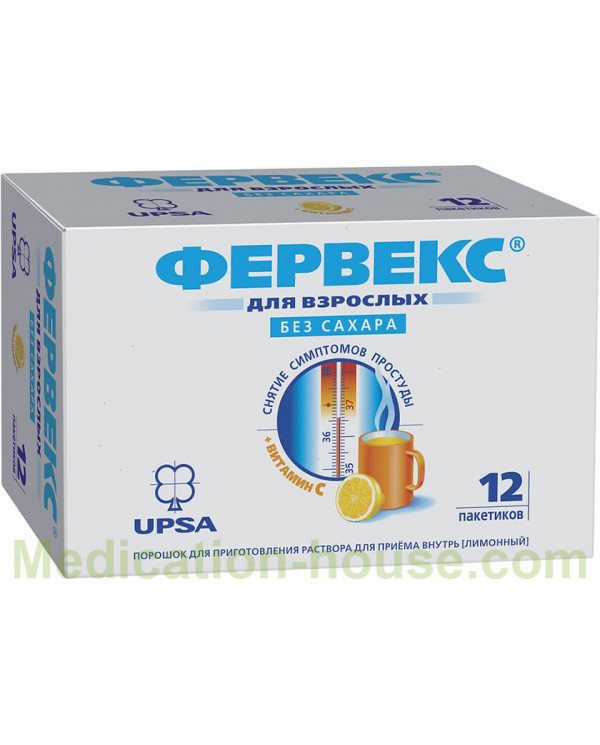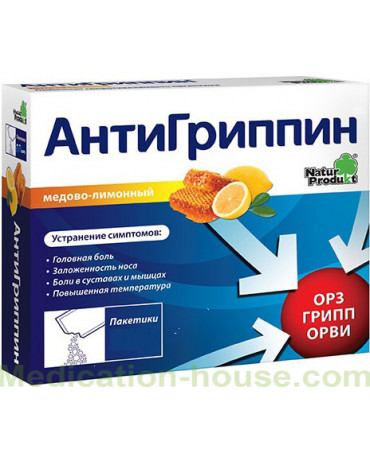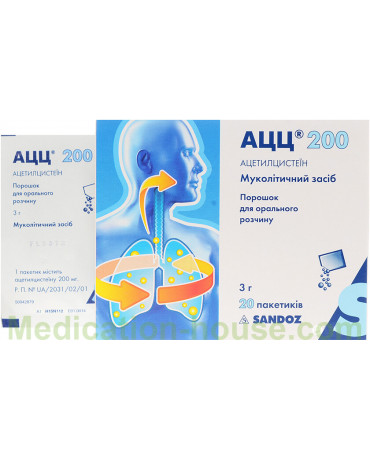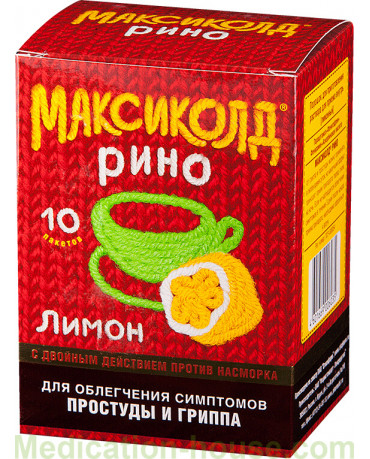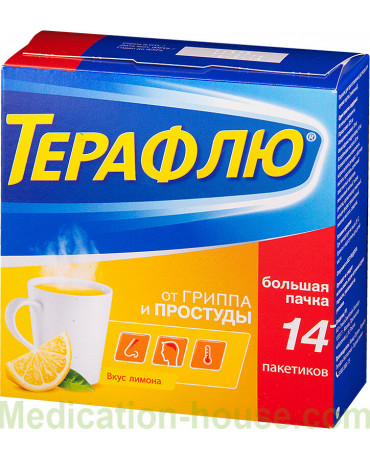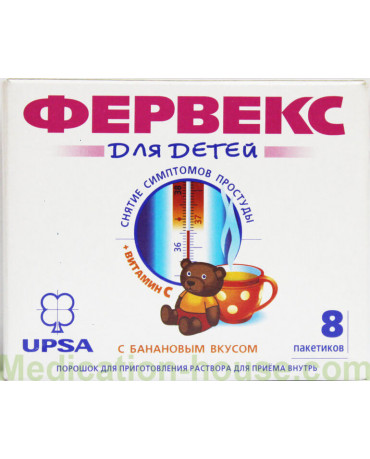Instruction for Fervex
You can buy Fervex here
Properties of the main components
Paracetamol is a medicinal substance that exhibits analgesic (non-narcotic) and antipyretic effects. Included in the group of anilides. It has the properties of blocking the activity of both forms of cyclogenase involved in the synthesis of prostanoids (prostaglandins, prostacyclins and thromboxanes), which leads to inhibition of prostaglandin synthesis reactions. The effect of the substance is localized to a greater extent in the region of the central nervous system, in particular on the pain and thermoregulatory center.
Peroxidase of peripheral tissue cells neutralizes the effect of paracetamol on cycloogenase, which blocks the anti-inflammatory effects of the active substance. Fervex component does not adversely affect the mucous membranes of the gastrointestinal tract and the water-salt metabolism in the body.
After oral use, the substance is actively and rapidly absorbed from the gastrointestinal tract. Achieving maximum concentration occurs from ten minutes to one hour. It has the properties of rapid distribution in tissues and penetrates the blood-brain barrier. Binding to plasma blood proteins is negligible, but tends to increase with increasing dosage.
Metabolic processes occur in the liver, about eighty percent of the amount consumed enter into conjugation reactions with sulfates and glucuronic acid in the formation of inactive derivatives. About seventeen percent is hydroxylated to produce eight active metabolites, one of which can have a hepatotoxic effect and has cumulation properties when the therapeutic dosage is exceeded. When taking Fervex in the prescribed amount, hepatotoxicity and cumulation are absent, which is explained by the neutralization of the metabolite in the process of connection with glutathione. The excretion of a medicinal substance occurs with the help of the urinary system in a metabolic form. The elimination half-life makes from one to three hours.
Pheniramine is a substance that blocks the activity of n1-histamine receptors, reduces exudative and spastic manifestations, reduces swelling and hyperemic manifestations on the mucous membranes of the nasal cavity, oropharynx and sinuses.
After oral administration, it is actively absorbed from the gastrointestinal tract, the maximum therapeutic concentration is achieved within one to two and a half hours, the duration of the therapeutic effect is about twenty-four hours. The half-life of the active substance is from sixteen to nineteen hours. Excretion occurs using the urinary system (about 70 - 83%).
Ascorbic acid exhibits pronounced reducing properties, it is part of the group of water-soluble vitamin substances. It takes part in oxidation-reduction reactions, the metabolism of carbohydrates and amino acids, and is involved in the metabolic reactions of thyroxine, catecholamines, steroid hormones, insulin, collagen and procollagen. It has a regenerative effect on connective and bone tissues. Helps to improve capillary permeability, absorption of iron-containing compounds, hemoglobin metabolism activity. Acid is necessary for the activity of blood coagulation processes, and also increases the nonspecific stability of the body, exhibits antidote properties. A lack of this substance can lead to hypo- and vitamin deficiency of vitamin C, since the human body does not produce ascorbic acid.
After oral administration, ascorbic acid is absorbed in the gastrointestinal tract (in the small intestine). Absorption processes can be disrupted with certain pathologies of the stomach and intestines, with worms, as well as after drinking alkaline drinks, fresh fruit and vegetable juices. Achieving maximum therapeutic concentration occurs within four hours. The active substance has the properties of active penetration into blood cells (white blood cells and platelets), and then into all body tissues.
Next, the process of depositing acid in various areas of the body. Metabolic processes take place predominantly in the liver region, with conversion to desoascorbic acid, and subsequently to oxaloacetic and diketogulonic acid. Acid has the properties of penetration into the secretion of mammary glands. Excretion of the substance occurs with the help of the urinary system and excretion. With an increased dosage, the activity of excretion increases sharply, and does not decrease immediately after cessation of use.
Indications for use
The drug Fervex is used for diseases caused by acute respiratory infections, as well as rhinopharyngitis, to alleviate the general condition of the patient and the development of the following symptoms:
With increased formation of mucus in the nasal region, as well as with a feeling of nasal congestion.
For headaches.
With increased body temperature of the patient.
When lacrimation and sneezing occur due to acute respiratory infections.
Contraindications
The following situations are contraindications for the use of the drug Fervex:
The presence of hypersensitivity or individual intolerance to the components that are included in the composition of the medicinal product.
The presence of lesions of the gastrointestinal tract of an erosive and ulcerative type of an acute nature.
Pathology of the functional activity of the liver.
The presence of angle-closure glaucoma.
Pathologies of the functions of the prostate and urinary system, causing a delay in the urination process.
The presence of portal type hypertension.
Alcohol abuse and alcoholism.
The presence of hereditary diseases (phenylketonuria), belonging to the group of fermentopathies, which is caused by a violation of amino acid metabolic processes (in particular phenylalanine).
The period of pregnancy, since there is no data on clinical trials confirming the safety of Fervex for fetal development and the health of the expectant mother.
The period of breastfeeding, since there are no data on clinical trials confirming the safety of Fervex for the health of the baby.
Age indicators up to fifteen years.
With extreme caution, therapy with Fervex is carried out in the presence of congenital pathologies associated with hyperbilirubinemia, with hepatitis of a viral or alcoholic nature, as well as in the elderly patient.
Side effects
Typically, Fervex is well tolerated, however, when conducting a therapeutic course, the following negative manifestations of side effects may develop:
Digestive system. It may cause nausea, indigestion, soreness in the epigastric region, and dry mouth. When conducting therapy at a dosage significantly exceeding the maximum therapeutic dose, the development of liver function disorders is possible.
Hematopoietic system. In rare cases, the development of anemia, thrombocytopenia and methemoglobinemia is possible.
Urinary system. In rare cases, urinary retention may develop. When conducting therapy in a dosage significantly exceeding the maximum therapeutic dose, the development of renal function impairment is possible.
The immune system. Allergic reactions may occur, manifested in the form of a rash, itching, redness of the skin, as well as angioedema.
The cardiovascular system. Perhaps the development of a feeling of palpitations, dizziness, a disorder of coordination functions, a nebula of consciousness. As well as disorders of concentration functions (more often in elderly patients).
Miscellanea. In rare cases, the development of paresis of accommodation, as well as the occurrence of drowsiness, is possible.
In case of development of negative manifestations, it is necessary to interrupt therapy and seek the advice of a specialist doctor.
Dosage and method of use
Fervex is used orally.
The standard dosage is one sachet twice - three times a day.
The powder contained in the bag must be dissolved in a glass of boiled and cooled water.
The maximum daily dosage is 4 grams of active substance (eight sachets) with a patient weighing more than fifty kilograms.
The duration of the therapeutic course is not recommended for more than five days.
The interval between uses is recommended to observe at least four hours. With pathologies of renal functions (creatinine clearance less than 10 ml / min), the interval for using Fervex should be increased to eight hours or more.
If during the treatment for five days there is no relief of the patient's condition, then therapy should be discontinued and a specialist doctor should be consulted.
Overdose
In case of an overdose, acute poisoning may develop, manifested in the following symptoms: a complete lack of appetite (anorexia), a feeling of nausea, pain in the epigastric region, increased sweating, blanching of the skin, drowsiness. After a few days, it is possible to develop damage to the liver. In severe overdose, manifestations of liver failure, hepatonecrosis, encephalopathy, convulsive symptoms and, in extreme cases, a coma that can lead to the death of the patient may develop.
In case of an overdose, discontinue therapy with Fervex immediately and consult a specialist doctor for help.
For treatment, gastric lavage, the use of enterosorbents, and the use of an antidote, acetylcysteine, should be performed.
In the future, symptomatic therapy is performed.
Features of use
Fervex is available in several varieties, with and without sugar, for patients with diabetic diseases it is necessary to carefully look at the composition of the product.
The simultaneous use of Fervex with agents containing paracetamol is not recommended, since this can cause hepatotoxic effects.
In the case of therapy with an increased dosage of Fervex, mental dependence may occur. To avoid overdose, it is necessary to take into account the amount of substance taken per day, which should not exceed four grams.
If it is necessary to use concomitant use with metoclopramide, domperidone and cholestyramine before starting therapy, you should consult a specialist doctor.
When conducting drug therapy, distortion of indicators obtained during clinical trials to determine the level of urea and glucose in the blood may occur.
The use of a medical device may cause hepatotoxic side effects in alcoholic hepatosis.
When conducting a long period of therapy at elevated dosages, blood tests should be monitored.
Interaction during complex therapy with other drugs
The simultaneous use with preparations containing ethanol increases the sedative effect of antihistamines, in particular pheniramine. It can also contribute to the occurrence of acute inflammatory processes in the pancreas (pancreatitis).
The simultaneous use of the drug Fervex with morphine derivatives, barbiturates, benzodiazepines, antipsychotics, anti-depressants, sedatives, included in the group of n1-blockers enhances the sedative effectiveness of these drugs and increases the likelihood of developing negative effects (delay urination, dry mouth cavities, constipation).
It is also necessary to take into account the possibility of developing manifestations of a central atropine-like type in the case of simultaneous use with drugs that have anticholinergic effects, in particular with antihistamines; antidepressant substances in the imipramine group; antipsychotics belonging to the phenothiazine series; drugs with activity against Parkinson's disease; as well as antispasmodics of the atropine-like type and disopyramide.
In the case of complex therapy of the drug, Fervex with agents exhibiting the properties of activating the oxidation of microsomes, in particular barbiturate substances, tricyclic antidepressants, drugs exhibiting an anticonvulsant effect, as well as rifampicin, ethanol, flumecinol and phenylbutazone, the likelihood of developing hepatoxic effects increases.
Concomitant use with glucocorticosteroids increases the possibility of glaucoma.
Conducting joint therapy with substances included in the group of salicylates increases the possibility of nephrotoxicity.
With simultaneous use with anticoagulant agents, their effectiveness increases.
Combined therapy with drugs with uricosuric effect, their effectiveness decreases.
Use of Fervex during pregnancy and lactation
Since there is currently no reliable information on the results of clinical trials in pregnant patients, it is not recommended to use the drug in this group of people.
If you need to use Fervex medication during lactation, it is recommended to interrupt breastfeeding.
Vehicle management and precision work
During the therapeutic course, Fervex may develop negative manifestations of side effects, expressed in dizziness, drowsiness, and loss of coordination. It is not recommended to control technical means and work with high-precision mechanisms throughout the course of therapy.
Alcohol interaction
It is forbidden to drink alcohol during medical treatment, as this can serve as a reason for the development of hepatoxicity and other liver pathologies.
Storage
Storage of the drug Fervex must be carried out at a temperature of from fifteen to twenty-five degrees. Subject to storage rules, the shelf life is thirty-six months.
Terms of sell
You can buy Fervex without a prescription.

